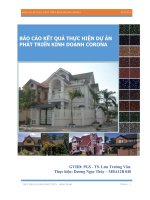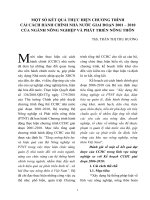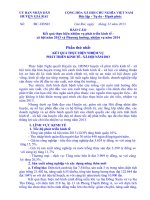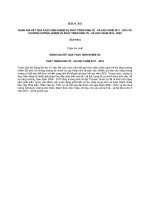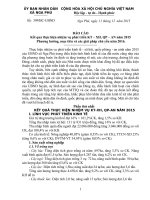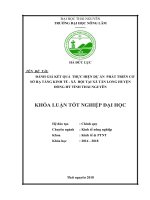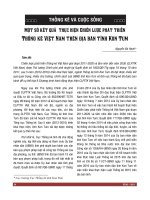KẾT QUẢ THỰC HIỆN CHIẾN LƯỢC PHÁT TRIỂN LÂM NGHIỆP VIỆT NAM GIAI ĐOẠN 2006–2020 VÀ ĐỀ XUẤT NỘI DUNG CHIẾN LƯỢC PHÁT TRIỂN LÂM NGHIỆP VIỆT NAM GIAI ĐOẠN 2021–2030, TẦM NHÌN ĐẾN NĂM 2050 - Full 10 điểm
Bạn đang xem bản rút gọn của tài liệu. Xem và tải ngay bản đầy đủ của tài liệu tại đây (1.15 MB, 65 trang )
OCCASIONAL PAPER
Vietnam Forestry Development Strategy
Implementation results for 2006–2020 and
recommendations for the 2021–2030 strategy
Trieu Van Hung
Pham Thu Thuy
Dao Thi Linh Chi
Occasional Paper 213
Vietnam Forestry Development Strategy
Implementation results for 2006–2020 and
recommendations for the 2021–2030 strategy
Trieu Van Hung
Independent consultant
Pham Thu Thuy
Center for International Forestry Research (CIFOR)
Dao Thi Linh Chi
Center for International Forestry Research (CIFOR)
Center for International Forestry Research (CIFOR)
Occasional Paper 213
© 2020 Center for International Forestry Research (CIFOR)
Content in this publication is licensed under a Creative Commons Attribution 4.0 International (CC BY 4.0),
/>ISBN 978-602-387-146-9
DOI: 10.17528/cifor/007879
Trieu VH, Pham TT and Dao TLC. 2020. Vietnam Forestry Development Strategy: Implementation results for 2006–2020 and
recommendations for the 2021–2030 strategy. Occasional Paper 213. Bogor, Indonesia: CIFOR.
Translation of: Triệu VH, Phạm TT và Đào TLC. 2020. Kết quả thực hiện Chiến lược phát triển Lâm nghiệp Việt Nam giai đoạn
2006–2020 và đề xuất nội dung Chiến lược phát triển Lâm nghiệp Việt Nam giai đoạn 2021–2030, tầm nhìn đến năm 2050.
Báo cáo chuyên đề 209. Bogor, Indonesia: CIFOR.
Photo by Terry Sunderland/CIFOR.
View from Northern Landscape, Vietnam.
CIFOR
Jl. CIFOR, Situ Gede
Bogor Barat 16115
Indonesia
T +62 (251) 8622-622
F +62 (251) 8622-100
E
cifor.org
We would like to thank all funding partners who supported this research through their contributions to theCGIAR Fund.
For a full list of the ‘CGIAR Fund’ funding partners please see: />Any views expressed in this publication are those of the authors. They do not necessarily represent the views of CIFOR,
the editors, the authors’ institutions, the financial sponsors or the reviewers
Contents
Acknowledgments
List of acronyms
Executive summary
vi
vii
viii
1 Introduction
1
2 Methods
2
3 General information on the 2006–2020 strategic objectives, orientation
and approach
3.1 Implementation during 2006–2010
3.2 Implementation during 2011–2015
3.3 Implementation during 2016–2020
3
4
7
8
4 Results of implementing VFDS during 2006–2020
4.1 Economic indicators
4.2 Environmental indicators
4.3 Social indicators
9
9
9
14
5 Results of program implementation
5.1 ‘Sustainable forest management and development’ program
5.2 ‘Protection, biodiversity conservation and development of forest
environmental services’ program
5.3 ‘Wood processing and forest product trade’ program
5.4 ‘Research, education, training and forestry extension’ program
5.5 ‘Institutional reform, policy, planning and monitoring’ program
19
19
6 Results of resource mobilization for implementation of the strategy
33
7 Lessons learned from implementation of the Forestry Development
Strategy 2006–2020
35
8 Recommendations for development of the 2021–2030 strategy,
with a vision until 2050
8.1 Global forestry development trends
8.2 Local proposals for future forestry development
8.3 Multi-disciplinary and comprehensive approach
38
38
38
38
23
25
27
27
References47
Appendix
1 List of forestry policies and laws made during 2006–2020
50
iv
List of figures, tables and boxes
Figures
1.
2.
3.
4.
5.
6.
7.
8.
9.
10.
11.
12.
13.
14.
The four strategic directions underpinning VFDS 2006–2020
The seven branches of strategy implementation
The strategy’s five target programs
Changes in forest area across the three types of forest during 2006–2019
Forest land area during 2006–2020
Forest area by owner during 2006–2019 (in ha)
Concentrated afforestation during 2006–2019
Development of plantation forest area 2006–2019
Timber production from planted forests 2006–2019
Total payment for forest environmental services (PFES) revenue
between 2011 and 2020
Export value of forest products between 2006 and 2020
Milestones in forestry policy development between 2004 and 2020
Local recommendations for forestry development after 2020
Strategic direction of development planning for the different forest types
3
4
4
20
21
21
21
22
22
24
26
32
41
41
Tables
1. Economic targets and implementation results
2. Reasons for not achieving the targets set out in the strategy
3. Forest product processing industry development: Implementation results
by ecological region
4. Implementation results in relation to environmental indicators
5. Implementation results in terms of area and rate of forest cover,
by ecological region (2006–2019)
6. Social goals and implementation results
7. ‘Sustainable forest management and development’ program: Objectives,
targets and implementation results
8. Ratio of planted forest (PT) to total forest area (TFA) during 2006–2019
9. ‘Protection, biodiversity conservation and development of forest environmental
services’ program: Objectives, targets and implementation results
10. Number of violations of the forest protection and development law and damage
to forest area
11. ‘Wood processing and forest product trade’ program: Objectives, targets
and implementation results
12. ‘Research, education, training and forestry extension’ program: Objectives,
targets and implementation results
13. ‘Institutional reform, policy, planning and monitoring’ program: Objectives,
targets and implementation results
10
11
13
14
15
16
19
22
23
25
26
28
30
v
14. Results of resource mobilization for implementation of the strategy
15. Challenges preventing the achievement of social and environmental
goals during 2006–2020
16. Local challenges in forestry development during 2006–2020
33
36
37
Boxes
1.
2.
3.
4.
5.
Results of 5 million ha reforestation project during 2006–2010
Main reasons behind the challenges of forest and forest land allocation in Vietnam
The challenges of improving the efficiency of PFES
Global trends to 2030
Twenty years of development in Vietnam
6
17
25
39
40
vi
Acknowledgments
This research is part of CIFOR’s Global
Comparative Study on REDD+ (www.cifor.
org/gcs). We would like to extend our sincere
thanks to the Norwegian Development Agency
(NORAD), the Global Climate Initiative (IKI) of
Germany’s Ministry of the Environment, Nature
Conservation, Construction and Nuclear Safety
(BMUB), as well as the CGIAR Research Program
on Forests, Trees, and Agroforestry (CRP-FTA)
and CGIAR donors.
We would also like to thank the leaders and experts
from the Vietnam Administration of Forestry, the
Vietnamese Ministry of Agriculture and Rural
Development, and various research organizations,
associations and international organizations
who gave their valuable time and support to this
research.
We would like to express sincere thanks to Nguyen
Thuy Anh and Nguyen Van Anh for assisting us in
the research process.
vii
List of acronyms
CIFOR
CITES
DARD
FES
FPDP
FSSP
FDI
FLEGT
GDP
GoV
MARD
NF
NTFP
ODA
PF
PFES
PTF
TPSFD
SFE
SFM
SUF
VFDS
VNFOREST
VPA
VNFF
Center for International Forestry Research
Convention on International Trade in Endangered Species
Department of Agriculture and Rural Development
Forest environmental services
Forest Protection and Development Plan
Forest Sector Support Partnership
Foreign direct investment
Forest Law Enforcement, Governance and Trade
Gross domestic product
Government of Vietnam
Ministry of Agriculture and Rural Development
Natural forest
Non-timber forest product
Official development assistance
Planted forest
Payment for forest environmental services
Protection forest
Target program for sustainable forestry development
State Forest Enterprise
Sustainable forest management
Special-use forest
Vietnam Forestry Development Strategy
Viet Nam Administration of Forestry
Voluntary Partnership Agreement
Vietnam Forest Protection and Development Fund
viii
Executive summary
The Vietnam Forestry Development Strategy
(VFDS) is one of the country’s most important
plans for the forestry sector. The strategic
directions, objectives and solutions within it differ
from time to time, depending on the political goals
and perspectives of the moment, as well as the role
that the forestry sector plays in Vietnam’s overall
socio-economic development. Regardless of such
changes, inheriting lessons learned, developing the
next strategy off the back of the experience gained
from solving previous challenges, and taking
advantage of opportunities, are always the top
priorities of the Government of Vietnam.
Vietnam’s first forestry development strategy,
introduced in 2006, aimed to transform the forestry
sector moving it away from a traditional approach
which valued forests only for direct benefits like
timber, towards a recognition of wide-ranging
indirect benefits like environmental services. This
strategic refocus embraced sector, landscape and value
chain approaches, as well as environmental and forest
ecological services approaches. The first strategy will
end in 2020; as such, the Ministry of Agriculture
and Rural Development (MARD) and the Viet Nam
Administration of Forestry (VNFOREST) are in
the process of developing a Forestry Development
Strategy for 2021–2030, with a vision to 2050.
This report is the result of a collaboration between
the Center for International Forestry Research
(CIFOR) and the Vietnam Administration of
Forestry (VNFOREST); it is intended to provide
VNFOREST with input as they develop the new
strategy. Based on secondary document research
and stakeholder interviews, the report reviews
achievements and challenges in the implementation
of VFDS 2006–2020, as well as provides
recommendations for policy makers to consider in the
process of developing the new strategy.
Research results show that, by 2020, Vietnam had
exceeded a number of the goals set out in VFDS
2006–2020, including: (i) accelerating the growth
of production value in the sector; (ii) increasing
the export value of wood and forest products; (iii)
increasing domestic wood production; and (iv)
planting protection forest (PTF) and special-use
forests (SUF). However, the forestry sector still
faces many challenges when it comes to other key
performance indicators, such as: (i) increasing the
area of production forests (PDF) with certification
of sustainable forest management (SFM); (ii)
increasing large-diameter timber production; (iii)
increasing revenue for forest environmental services
(FES); (iv) securing forest and forest land for the
purposes of allocation and leases; (v) reducing the
number of poor households in forestry areas; and
(vi) increasing the rate at which forestry workers
are trained.
Although some anticipated targets were not
achieved, others were exceeded, for example:
forest cover; reforestation after logging; reduction
of forest protection violations; and scattered
tree planting. That these goals were achieved
or exceeded is the result of strong political
commitment, policies trend-matching the market,
improvements in central and local management
capacity, the active support of international donors,
and the involvement of civil society and the private
sector. That some targets were not achieved is
due to the challenges of implementing policy
effectively, efficiently and equitably at grassroots
level, lack of resources and funding, and some
ambitious goals and targets not being realistic
in the current economic, political and market
contexts.
ix
Addressing these challenges requires a new
approach and more effective economic, social
and technical solutions. Development of VFDS
2021–2030 and the 2050 vision needs to consider
the implementation achievements and challenges
of the previous policy, as well as how to align with
global trends, and balance these with the current
political, economic and social development context
in Vietnam. The direction of the new strategy must
also be considered in the context of international
requirements, to facilitate the mobilization of
domestic and foreign financial resources to help
modernize the industry, as well as enhance the
forestry sector’s role and value in terms of poverty
reduction, sustainable economic development and
ensuring sustainable forest ecosystems.
1 Introduction
VFDS 2006–2020 was approved by the Prime
Minister of Vietnam in Decision No. 18/2007/
QD-TTg dated 5 February 2007. Over the last
15 years, the forestry sector has implemented this
strategy through various different programs, plans
and projects. This has resulted in many important
achievements, contributing to increased awareness
around the importance of forest resources and
attracting the attention and support of the whole
society for them, as well as actively contributing
to socio-economic development, environmental
protection and climate change objectives
(VNFOREST 2020a).
Besides these achievements, the forestry sector also
saw some shortcomings, such as restricted planning
and planning management, land disputes and the
violation of forest protection and development
regulations, which in some places were serious.
Likewise, although overall forest area has increased
in Vietnam, forest quality remains low; natural
forest (NF) has recovered slowly, the productivity
of planted forest (PF) has been improved but is still
low, resulting in small-diameter timber which does
not meet raw material demands of the processing
and export industries (VNFOREST 2020a).
The year 2020 marks an important milestone in
the process of formulating policies, strategies and
plans for socio-economic development of the
country, as well as for Vietnam’s forestry sector.
The review and evaluation of VFDS 2006–2020
implementation, and the development of the next
VFDS, are essential foundations for development
in the forestry sector overall. To support
implementation of this strategic review, evaluation
and development, MARD has issued Decision No.
4587/QD-BNN-TCLN dated 9 November 2017.
This report is a joint product of the Center
for International Forestry Research, and the
Planning and Finance Department of the Vietnam
Administration of Forestry, Ministry of Agriculture
and Rural Development. The objective of the
report is to fully and objectively assess the results
of the implementation of the VFDS 2006–2020,
to analyze the achievements as well as the
shortcomings, limitations and causes, drawing
lessons learned as a basis for proposing and
recommending issues to be considered and solved
in the development of the VFDS for 2021–2030,
with a vision to 2050.
The report is built on the basis of an overview of
secondary sources, including reports of central and
local government agencies, reports of domestic and
foreign organizations, local reports on the results
of VFDS 2006–2020 implementation, combined
with the results of consultation with representatives
of 32 related organizations.
2 Methods
This report is based on three approaches.
Review of secondary documents. The research
team reviewed scientific reports, as well as reports
from donors, government agencies, domestic and
foreign research institutions and enterprises. These
reports related to the effectiveness of forestry policy
implementation during 2006–2020, as well as
proposals around the development of Vietnam’s
forestry strategy during 2021–2030 and the 2050
vision. The authors also consulted 49 reports
relating to VFDS 2006–2020 implementation in
49 provinces and cities that have forests. Provincial
reports were written in response to VNFOREST’s
request, through Document No. 1549/TCLNKHTC dated 3 October 2019.
In-depth interviews with organizations and
independent experts. The authors interviewed 22
state agency officials and 18 experts from related
organizations. These interviews focused on:
• the achievements and challenges of
implementing VFDS 2006–2020
• stakeholders’ perspectives on the strategic
direction that forestry development should take
in the next stage
• directions and lessons learned from
implementation of other strategies, for example,
the National Science and Technology Strategy,
Biodiversity Conservation Strategy, Forest
Sector Research Strategy, Human Resources
Training Strategy, and Decree 99 and 156 on
Payment for Forest Environmental Services
(PFES)
• the results of implementing forestry programs
and plans, and proposed directions for the
2021–2030 period.
Traffic light evaluation. To facilitate our
assessment, we used a traffic light system to assess
the achievement level of the various targets and
programs outlined in VFDS 2006–2020.
Achieved or exceeded the set targets
The targets set out in VFDS 2006–2020
were not achieved, but compared with
targets set out in other documents, targets
have been exceeded or partially achieved
Targets were not met
No data to evaluate
3 General information on the 2006–2020
strategic objectives, orientation and
approach
VFDS 2006–2020 was approved by the Prime
Minister in Decision No. 18/2007/QD-TTg with
the overall goal of:
‘Establishing, managing, protecting, sustainable
development and use of 16.24 million ha of land
planned for forestry; increase the percentage of
forested land to 42–43% by 2010 and 47% by
2020; ensure broad participation of economic sectors
and social organizations in forestry development to
contribute increasingly to socio-economic development,
protect ecological environment, conserve biodiversity
and provide environmental services, contribute to
poverty reduction, improve living standards for rural
mountainous people and maintain national security
and defense’.
VFDS 2006–2020 provided four strategic
directions (Figure 1) and seven implementation
solutions (Figure 2) through five programs
(Figure 3), with the total capital required for
implementation estimated at VND 33,885.34
billion, to be sourced from: state budget (23.9%);
state-issued credit scheme (15.6%); official
development assistance (ODI) (13.1%); state
enterprises and cooperatives (11.3%); foreign
direct investment (FDI) (24.5%); and other
sources (0.4%).
In reality, implementation of VFDS 2006–2020
has not been organized according to the programs
approved in Decision 18 of the Prime Minister, but
instead according to the programs and projects that
have been issued in the three respective phases of
the strategy (2006–2010, 2011–2016 and 2017–
2020). Evaluation of progress and implementation
results are outlined in the following sections.
Strategic direction
Planning for three types of forest and forest land*: 16.24 million
ha, including 5.68 million ha of Protection Forest; 2.16 million ha
of Special-use Forest; and 8.4 million ha of Production Forest
Management, protection and development of forests so that
16.24 million ha of forests and forest land are uniformly
managed, on the basis of a stable national forest estate
Use forests and develop the forest product processing industry so
that products are highly competitive, use advanced technology
and respond to market needs
To develop forestry in 7 ecological regions: Northern Midlands and
Mountains (including 2 sub-regions: Northwest and Northeast),
Northern Delta, North-Central Coast, South-Central Coast, Central
Highlands, Southeast and the Mekong River Delta
Figure 1. The four strategic directions underpinning VFDS 2006–2020
* In Vietnam ‘forest land’ is land assigned by the government for forestry purposes. As such, it may
not be forested, but the intention is for it to become forested.
4 |
Trieu Van Hung, Pham Thu Thuy and Dao Thi Linh Chi
1. Reforming policies on forest management, forest land, finance and credit
2. Innovating production and business systems
3. Planning, monitoring and evaluation
4. Sectoral organization and management
5. Science and technology
6. Human resource training
7. International cooperation
Figure 2. The seven branches of strategy implementation
Strategic programs
1.
Sustainable
forest
management
and
development
2.
Protection and
conservation of
biodiversity and
development of
environmental
services
3.
Wood
processing and
forest product
trade
4.
Research,
education,
training and
forestry
extension
5.
Institutional
innovation,
policy, planning
and sectoral
monitoring
Figure 3. The strategy’s five target programs
3.1 Implementation during 2006–2010
During 2006–2010, implementation of the 5
million ha reforestation project was continued
(Program 661 according to Decision 661/QDTTg dated 29 July 1998 of the Prime Minister).
To implement this reforestation project, a
State Steering Committee and Central Project
Management Board were established centrally,
according to the Decision of the Prime Minister;
in the localities, a Provincial Steering Committee
was established by the leader of the Provincial
People’s Committee, along with a provinciallevel Project Management Unit, headed by the
leader of Department of Agriculture and Rural
Development (DARD). Project management
units were also established at grassroots level (GoV
2011). This same system of executive steering was
maintained and strengthened in the following
stages, although it went under a different name.
VFDS 2006–2020 was formulated with the
active and effective support of many international
organizations through the Forest Sector Support
| 5
Vietnam Forestry Development Strategy
Partnership (FSSP) that provided comprehensive
direction for development of the forestry sector.
Since 2004, so as to monitor the sector, the FSSP
has supported MARD to develop a Forestry Sector
Monitoring Information System (FORMIS) with a
set of 36 indicators. In 2006, this set of indicators
was revised and supplemented to monitor and
evaluate implementation of VFDS 2006–2020;
the revised version included 72 indicators, of
which 15 were key indicators, but at that time
there was no data available for the purposes of
monitoring and evaluation; these were thus named
‘future indicators’. The indicator set is divided
into four groups: i) the overarching goal, with
four indicators; ii) specific economic, social and
environmental targets, with 13 indicators; iii)
program-related performance targets, with 47
indicators; and iv) inputs, including 8 indicators
(MARD, FSSP 2010).
The 2006 Forestry Sector Report, which outlines
the above-mentioned criteria system, is considered
to be the baseline report from which to monitor
and oversee implementation of VFDS 2006–2020.
In 2010, MARD with support of the FSSP,
developed a ‘Forest Sector Progress Report 2006–
2010’ to analyze changes in the forestry sector
over the first five years of strategy implementation,
looking at reasons behind the achievement and
failure of important sector targets, as well as
forestry development trends in Vietnam and the
world. This report made recommendations.
According to MARD and FSSP (2010), during
2006–2010, the forestry sector achieved several
important achievements:
• forestry activities shifted from state-based to
social forestry, with many economic sectors
getting involved; the key players in reforestation
activities were local households, while in forest
product processing, private enterprise played a
critical role.
• forestry projects were implemented effectively.
In particular, Project 661 and official
development assistance (ODA) projects
changed the perception of government agencies
and society around the role and impacts of
forests.
• growth in forestry production value reached
an average of 2.8%/year; forestry GDP
accounted for about 1% of the national GDP
(if both direct (e.g. timber) and indirect (e.g.
environmental services) benefits were included
in this calculation, GDP reached 3–5%);
• Furniture exports reached USD 3.2 billion in
2010, meeting the strategy’s target.
• Forest cover increased from 37% in 2005 to
39.5% in 2010, but did not meet the strategy’s
target.
• Timber production increased from 3.2 million
m3 in 2006 to 4.95 million m3 in 2010, of
which plantation timber accounted for 92%.
• The poverty rate decreased during 2006–2009
in the forest-rich provinces; from 2004 to 2008,
in the Northern Midlands and Mountains, the
rate decreased from 38.35 to 31.6%; in the
North Central and Central Coast regions it
decreased from 25.9% to 18.4%; while in the
Central Highlands it decreased from 33.1% to
24.1%.
• Various technical advances, especially regarding
tree species, have been applied in production,
contributing to an increased productivity
and quality of planted forests, in some places
reaching 15–20 m3/ha/year.
• Many breakthrough policies were issued:
Decision 147/2007/QD-TTg on PDF
development brought PDF area to 838,830
ha, equaling 112% of the target; Decision
380/2007/QD-TTg on piloting, and then
Decree 99/2010/ND-CP on PFES policy made
Vietnam the first country in Southeast Asia to
implement PFES; Decree 117/2010/ND-CP on
organization of SUF management was also key.
Because the forestry sector focused on
implementing the 5 million ha reforestation
project, review and assessment of the 2006–2010
period is mainly based on the objectives, tasks,
policies and implementation of the 5 million ha
reforestation project (Decision 661/QD-TTg
dated 29 July 1998) and Resolution No. 73/2006/
QH dated 29 November 2006 of the National
Assembly, adjusting the targets and tasks of the 5
million ha reforestation project during 2006–2020
(GoV 2011, see also Box 1).
According to Pham et al. (2012), during 2006–
2009, the increase in Vietnam’s forest area was
mainly due to: an increase in planted forests; the
government carrying out a national forest land
reform; the application of new technology; market
opportunities for forest products; and increased
agricultural output. The increase is also due in part
to the new classification of ‘forest’; this includes
‘neglected forest’, as it appeared in the previous
forest classification, and ‘regenerated natural forest
area’, which is mainly bamboo forest.
6 |
Trieu Van Hung, Pham Thu Thuy and Dao Thi Linh Chi
Box 1. Results of 5 million ha reforestation project during 2006–2010
•
•
•
•
•
•
•
•
•
1,140,630 ha reforested, achieving 114% of the target
922,768 ha zoned for natural regeneration, achieving 115% of the target
1,351,019 ha forest management (achieving 95% of the target)
2,507,355 ha contracted for forest protection (achieving 167% of the target)
Forest coverage in 2010 was 39.5%, an increase of 2.4% compared to 2005
Total timber stock in 2010 was 935.3 million m3, an increase of 15% compared to 2005
5 million m3 was logged from plantation forest in 2010
Contributions to job creation and poverty reduction
Because forest plantation increased and more forests are planted
Sources: GoV 2011; VNFOREST 2020a
MARD and FSSP (2010) also pointed out certain
shortcomings in the forestry sector:
• Forestry sector growth is unsustainably low,
with little profitability, weak competitiveness,
and untapped forest potential, especially
in terms of large-diameter timber, nontimber forest products (NTFPs) and forest
environmental services (FES).
• Plantation forests with low productivity and
quality have failed to meet demand in terms of
large-diameter timber for processing and export.
• Wood and NTFP processing industries are
developing fast but they are spontaneous and
unstable, marked by a lack of planning and
strategic vision. There is low competition
(which exists mainly in processing), combined
with a lack of supporting industries, established
branding and investment to modernize
the industry; wood sources are also mainly
imported.
• The impact of the sector on poverty reduction
remains very limited.
• The impact of forests on the environment is
limited; the role and function of natural forests
in environment protection and biodiversity
conservation is limited.
• The overarching problem in the sector is a
lack of capital for all three types of forests;
The budget for forestry remains low and is not
comparable to that received by other sectors.
Natural forest area continued to decrease
during this period, and mangroves were also
severely degraded (Pham et al. 2012). Although
afforestation resulted in an increase in the forested
area, data shows that most of this area was covered
with plantations, while the remaining natural forest
was in a poor state or under restoration. The main
trend is still to develop and manage fragmented
forests, and therefore a lot of forest was degraded
during this period. Poor natural forests with timber
volumes of less than 80 m3/ha accounted for more
than 80% of the total forest area during 2006–
2020 (Pham et al. 2012).
The reports of the GoV (2011) and VNFOREST
(2010) also highlighted that the main
achievements and results of this period were due
to: the significant determination of the Party and
State, approved by the National Assembly; active
application of market mechanisms; attention
being paid to the socio-economic interests of
people living near forests; importance being
attached to planning and implementation of
plans; the promotion of forest land allocation
and long-term land-use rights for organizations,
households and individuals; the completion of
policies to encourage various economic sectors to
invest in afforestation; the strengthening of state
management; decentralization of local project
implementation; the application of science and
technology on different tree species and varieties;
and the application of intensive farming techniques
to improve project efficiency.
MARD and FSSP (2010) also give many
recommendations for the next period to address
existing challenges, including: gradually replacing
imported wood; improving the quality of Natural
Forests and Plantation Forests; completing
investment policies for PTF and SUF; supporting
plantation forest for timber production; varieties
| 7
Vietnam Forestry Development Strategy
and afforestation of large-diameter timber;
supporting three forest types towards sustainable
management through certification, prioritizing
production forest; forest land-use planning;
establishing a stable national forest estate;
promoting implementation of PFES; building
forestry corporations for large-diameter timber
forestation; allocating forest land to mountainous
households lacking agricultural land; innovating
wood processing technologies to achieve high
added value; and adopting policies to support
technology innovation, including in supporting
industries. MARD and FSSP (2010) also
emphasized the need to: improve sector monitoring
indicators and collect data; develop progress reports
for the strategy; and increase the participation of
stakeholders in the development, implementation
and monitoring of policy.
3.2 Implementation during 2011–2015
In this phase, the Forest Protection and
Development Plan (FPDP) for 2011–2020 was
implemented (according to Decision No. 57/QDTTg dated 9 January 2012 of the PM approving
the FPDP for 2011–2020). At central level, a
FPDP State Steering Committee and Office were
established; a provincial-level Steering Committee
was also established for FPDP Report 2006–2010’
was the first progress report to evaluate the results
of VFDS 2006–2020 implementation; this was
followed by a second report in 2015 and a third
in 2020 (Le 2010). From 2010 onwards, however,
monitoring of forestry sector activities against the
established targets did not happen systematically.
As such, information and data that can be used
to evaluate the previous strategy’s implementation
are scattered and unsystematic, so it is difficult to
evaluate the effectiveness of VFDS 2006–2020.
However, in 2011, VNFOREST compiled and
published the book ‘Vietnam Forestry in the
first decade of the 21st century’ which recorded
some of this period’s achievements, including: the
restoration and development of forest resources;
the revision, supplementation and improvement
of forestry legal systems and policies; and an
increase in international cooperation in forestry.
This book also highlights five main challenges
the forestry sector faced over this period. These
include: i) development challenges, like lack
of capital, land disputes, weak management of
enterprises, especially state forestry enterprises,
weak market, and poor quality human resources
and infrastructure; ii) poor quality forest resources,
low production capacity and an undeveloped
rural economy; iii) a lack of public awareness
around the requirements of sustainable forestry
development; iv) mechanisms and policies not yet
in place to advance livelihood improvements for
forest workers; v) root causes underlying forestry
development challenges not having been fully
identified and analyzed.
In 2011, MARD (2011) also stated that to develop
the forestry sector well during 2016–2020, it
would be necessary to: (i) have proper awareness of
SFM; ii) absorb and appropriately apply the global
forest management trends; iii) develop private and
cooperative economies, and diversify the economic
sectors involved in forestry; iv) promote science
and technology research, and rapidly transfer new
technology into production; and v) clearly define
the role of the state in terms of forest management
interventions. A number of advantages and
opportunities were also predicted to have positive
future impacts on forestry in Vietnam: i) an
increase in internal resources; ii) improvements to
the structure of the forest industry; the increase in
planted production forests; developments to the
wood processing industry; and a promising outlook
for PFES; iii) forestry-related professions have had
positive impacts in the economic development
of households, contributing to poverty reduction
among mountainous people; iv) forestry was
recognized by society as contributing to overall
country development.
According to MARD’s report (2011), the
forestry sector was also predicted to face five new
challenges during 2016–2020: i) many potential
risks to sustainable development within forestry;
ii) low quality forest development and forestry;
iii) natural, economic and social conditions
posing new difficulties like the deteriorating
productivity of forest land, access difficulties,
inefficient protection of natural forests, human
resource difficulties; iv) emerging challenges in
managing natural forests to meet conservation
and economic requirements; and v) international
aid grants being reduced. These challenges
resulted in the forestry sector’s primary objectives,
tasks and solutions being readdressed in the
Forest Protection and Development Plan for
2011–2020, under Decision No. 57/QD-TTg
dated 9 January 2012 (MARD 2011).
8 |
Trieu Van Hung, Pham Thu Thuy and Dao Thi Linh Chi
During 2011–2015, results from the first five
years of the FPDP for 2011–2020 were reviewed
and evaluated in line with the Prime Minister’s
Decision No. 57/QD-TTg dated 9 January
2012. The Prime Minister then approved
the Target Program for Sustainable Forestry
Development (TPSFD) for 2016–2020 in
Decision No. 886/QD-TTg dated 16 June 2017,
replacing Decision No. 57, to comply with the
national target mechanism under the National
Assembly’s Resolution No. 18/2011/NQ-QH13
(Nguyen 2019).
3.3 Implementation during 2016–2020
This phase saw implementation of the TPSFD for
2016–2020 (according to Decision No. 886/QD-
TTg dated 16 June 2017 approving this program).
This involved establishment of a State Steering
Committee and Office on TPSFD (GoV 2019).
According to interviewed stakeholders, many
forestry-related innovations took place during
2016–2020. Interviews with VNFOREST
representatives indicated that TPSFD 2016–2020
(hereinafter referred to as Program 886) achieved
some key results. In 2018, targets for planted
forest area, forest cover, timber output, and export
values for wood and forest products, were all
met or exceeded. A comprehensive report and
evaluation of this phase, with supporting data, are
to be finalized by the end of 2020, however, so at
the time of writing this report, there had been no
evaluation.
